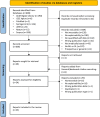Exploring the Applications of Explainability in Wearable Data Analytics: Systematic Literature Review
- PMID: 39718820
- PMCID: PMC11707450
- DOI: 10.2196/53863
Exploring the Applications of Explainability in Wearable Data Analytics: Systematic Literature Review
Abstract
Background: Wearable technologies have become increasingly prominent in health care. However, intricate machine learning and deep learning algorithms often lead to the development of "black box" models, which lack transparency and comprehensibility for medical professionals and end users. In this context, the integration of explainable artificial intelligence (XAI) has emerged as a crucial solution. By providing insights into the inner workings of complex algorithms, XAI aims to foster trust and empower stakeholders to use wearable technologies responsibly.
Objective: This paper aims to review the recent literature and explore the application of explainability in wearables. By examining how XAI can enhance the interpretability of generated data and models, this review sought to shed light on the possibilities that arise at the intersection of wearable technologies and XAI.
Methods: We collected publications from ACM Digital Library, IEEE Xplore, PubMed, SpringerLink, JMIR, Nature, and Scopus. The eligible studies included technology-based research involving wearable devices, sensors, or mobile phones focused on explainability, machine learning, or deep learning and that used quantified self data in medical contexts. Only peer-reviewed articles, proceedings, or book chapters published in English between 2018 and 2022 were considered. We excluded duplicates, reviews, books, workshops, courses, tutorials, and talks. We analyzed 25 research papers to gain insights into the current state of explainability in wearables in the health care context.
Results: Our findings revealed that wrist-worn wearables such as Fitbit and Empatica E4 are prevalent in health care applications. However, more emphasis must be placed on making the data generated by these devices explainable. Among various explainability methods, post hoc approaches stand out, with Shapley Additive Explanations as a prominent choice due to its adaptability. The outputs of explainability methods are commonly presented visually, often in the form of graphs or user-friendly reports. Nevertheless, our review highlights a limitation in user evaluation and underscores the importance of involving users in the development process.
Conclusions: The integration of XAI into wearable health care technologies is crucial to address the issue of black box models. While wrist-worn wearables are widespread, there is a notable gap in making the data they generate explainable. Post hoc methods such as Shapley Additive Explanations have gained traction for their adaptability in explaining complex algorithms visually. However, user evaluation remains an area in which improvement is needed, and involving users in the development process can contribute to more transparent and reliable artificial intelligence models in health care applications. Further research in this area is essential to enhance the transparency and trustworthiness of artificial intelligence models used in wearable health care technology.
Keywords: XAI; analytics; deep learning; explainable artificial intelligence; health informatics; interpretation; machine learning; user experience; wearable; wearable data; wearable sensors.
©Yasmin Abdelaal, Michaël Aupetit, Abdelkader Baggag, Dena Al-Thani. Originally published in the Journal of Medical Internet Research (https://www.jmir.org), 24.12.2024.
Conflict of interest statement
Conflicts of Interest: None declared.
Figures














Similar articles
-
Systematic literature review on the application of explainable artificial intelligence in palliative care studies.Int J Med Inform. 2025 Aug;200:105914. doi: 10.1016/j.ijmedinf.2025.105914. Epub 2025 Apr 8. Int J Med Inform. 2025. PMID: 40250167
-
Local interpretable model-agnostic explanation approach for medical imaging analysis: A systematic literature review.Comput Biol Med. 2025 Feb;185:109569. doi: 10.1016/j.compbiomed.2024.109569. Epub 2024 Dec 19. Comput Biol Med. 2025. PMID: 39705792
-
The enlightening role of explainable artificial intelligence in medical & healthcare domains: A systematic literature review.Comput Biol Med. 2023 Nov;166:107555. doi: 10.1016/j.compbiomed.2023.107555. Epub 2023 Oct 4. Comput Biol Med. 2023. PMID: 37806061
-
Designing Clinical Decision Support Systems (CDSS)-A User-Centered Lens of the Design Characteristics, Challenges, and Implications: Systematic Review.J Med Internet Res. 2025 Jun 20;27:e63733. doi: 10.2196/63733. J Med Internet Res. 2025. PMID: 40540451 Review.
-
Health professionals' experience of teamwork education in acute hospital settings: a systematic review of qualitative literature.JBI Database System Rev Implement Rep. 2016 Apr;14(4):96-137. doi: 10.11124/JBISRIR-2016-1843. JBI Database System Rev Implement Rep. 2016. PMID: 27532314
References
-
- Iqbal MH, Aydin A, Brunckhorst O, Dasgupta P, Ahmed K. A review of wearable technology in medicine. J R Soc Med. 2016 Oct 11;109(10):372–80. doi: 10.1177/0141076816663560. https://europepmc.org/abstract/MED/27729595 109/10/372 - DOI - PMC - PubMed
-
- Duckworth C, Guy MJ, Kumaran A, O'Kane AA, Ayobi A, Chapman A, Marshall P, Boniface M. Explainable machine learning for real-time hypoglycemia and hyperglycemia prediction and personalized control recommendations. J Diabetes Sci Technol. 2024 Jan 13;18(1):113–23. doi: 10.1177/19322968221103561. https://journals.sagepub.com/doi/abs/10.1177/19322968221103561?url_ver=Z... - DOI - DOI - PMC - PubMed
-
- Barricelli BR, Casiraghi E, Gliozzo J, Petrini A, Valtolina S. Human digital twin for fitness management. IEEE Access. 2020;8:26637–64. doi: 10.1109/access.2020.2971576. - DOI
-
- Saeed W, Omlin C. Explainable AI (XAI): a systematic meta-survey of current challenges and future opportunities. Knowl Based Syst. 2023 Mar;263:110273. doi: 10.1016/j.knosys.2023.110273. - DOI
-
- Adadi A, Berrada M. Peeking inside the black-box: a survey on explainable artificial intelligence (XAI) IEEE Access. 2018;6:52138–60. doi: 10.1109/access.2018.2870052. - DOI
Publication types
MeSH terms
LinkOut - more resources
Full Text Sources
Miscellaneous

